With age, the bitter-tasting tannins in wine gradually disappear, giving a smoother taste and richer aroma. This is why older wines are so highly prized. But why wait ten years to drink that bottle?
By using a glass with built-in aerator, you can quickly maximize the quality of your wine by evaporating the compounds which give it a harsh flavor. Tannins are highly volatile in contact with oxygen, so contact with air will soften the flavor of your wine and mimic the taste of a vintage bottle.
Traditionally, red wine would be poured into a decanter a few hours before being drunk, allowing it to begin oxidizing. But this can be quite an unpredictable process, as speed of oxidation is affected by everything from the temperature of the room to the width of the decanter’s neck.
Will your bottle be ready before dinner is served? Who knows? Using a self-aerating wine glass takes out some of the guesswork, since you can treat each glass of wine at a predictable rate.
Aeration brings out all greater depth of flavor in a good-quality bottle of wine, amplifying subtle background flavors. There are many compounds – like sulfide preservatives – which are side-effects of the wine making process but do nothing for the flavor of the wine.
Letting your wine air will drive off these unwelcome flavors, allowing you to notice delicate tastes which would otherwise be masked.
It makes a particular difference in the case of young reds, which tend to have a heavy tannin profile undercutting their full-bodied flavors.
And if you can’t afford this year’s burgundy, careful aeration will ‘burn off’ some of the harsher ethanol notes in a cheaper bottle. It’ll turn your $10 bodega plonk into something you can serve to guests.
Oxidation boosts the flavor of wine but also hastens the process of spoiling, so once a bottle has been decanted it really needs to be finished the same evening.
Using kinetic aeration allows you to enjoy your bottle to the last drop: by using a glass with built-in aerator, you can enjoy a delicious glass of wine with dinner and store the rest of the bottle to enjoy another day.
Traditionally, only red wines were aerated, since waiting for wine to aerate also meant letting it warm up to room temperature.
There are some off-dry whites, like Alsace and white Burgundy, which benefit from aeration due to their relatively high tannin base.
And by using a self-aerating glass, you can evaporate the harsh ethanol notes quickly and enjoy the wine while it’s still chilled.
1. Godinger Aerating Wine Glass Stemless Goblet Wine Aerator
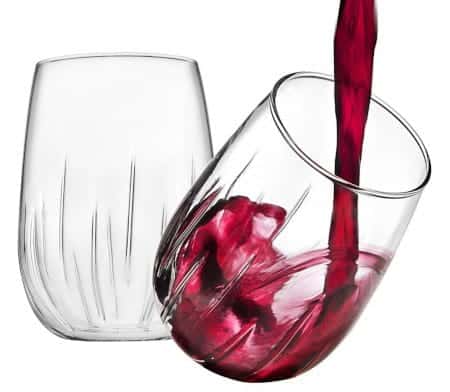
These stemless aerating wine glasses feature vertical ridges to agitate the wine as it is swirls, increasing the uptake of oxygen and providing a smoother taste. They’re made from thin glass, giving them a classic look similar to cut crystal. Be aware that the vertical ridges tend to guide the wine upwards, so keep it filled below the halfway mark to avoid the risk of wine spatters on your carpet.
2. Stemless Aerating Wine Glasses by Chevalier Collection
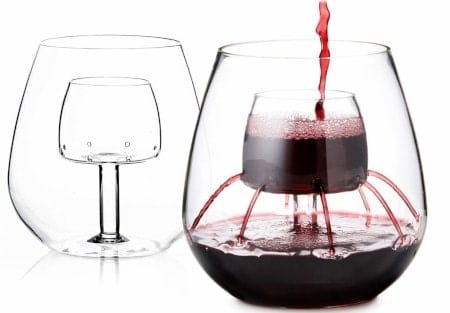
These handblown glasses with built-in aerator look like two glasses in one: pour your wine into the smaller central container and watch it spurt through the tiny holes, to catch in the larger drinking glass. Pushing the wine through multiple narrow apertures means that the largest possible surface area of wine comes into contact with air, for sublime kinetic aeration.
3. Aura Glass | No Spill Aerating Glass for Wine & Spirits with Custom Wood Oak Coasters
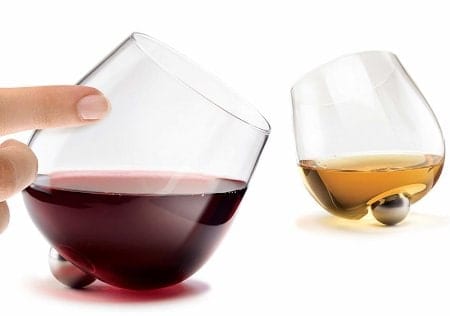
Resting on a stainless-steel ball instead of a flat base, these spinning wine tumblers can be set rotating with a push of the finger to swirl and aerate the wine. Once you’re happy with the flavor profile of your wine, simply set the glass in the matching donut-shaped coaster to hold it still on the tabletop.
Did you know?
There are two common types of self-aerating glasses. Spinning wine tumblers have an uneven base so they rotate when pushed, swilling the wine around and increasing the surface area coming into contact with air.
They’re a great conversation starter – and much harder to knock over than they look. Another style of glass has a rippled and textured interior, forcing miniature air bubbles into the body of the wine for even faster oxidation.
4. Sempli Cupa-Vino Clear Aerating Wine Glasses
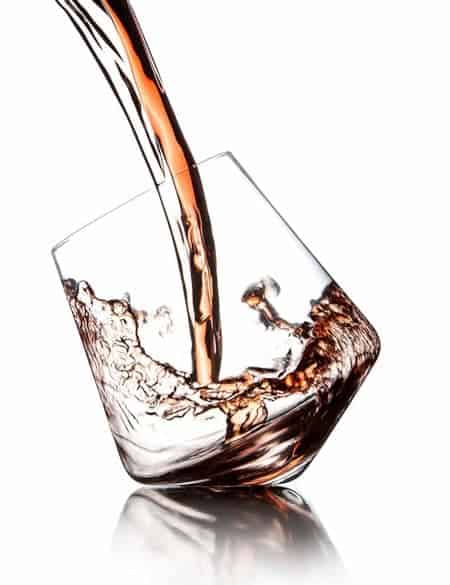
Halfway between a brandy snifter and a Viking drinking horn, these glasses feature a shallow cone at the base. Push them gently to rotate and swill the wine, slowly aerating from the surface downwards. Though they look and feel delicate, they’re almost impossible to knock over or spill.
5. Shatterproof Reusable Unbreakable Plastic Self Aerating Wine Cups
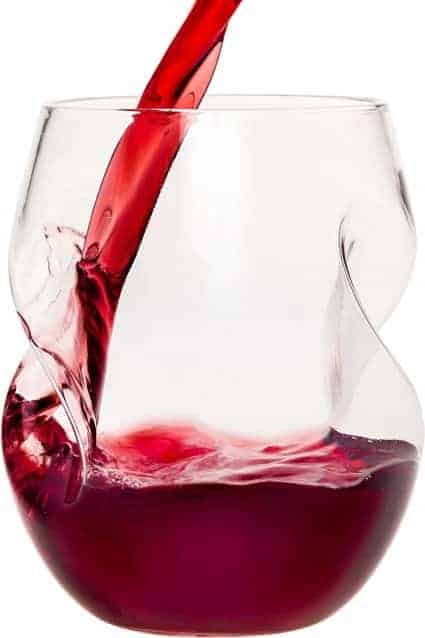
If you like to host, you’ll know there’s nothing worse than the sound of breaking glass. If you want a middle choice between risking your best glassware and serving your guests out of red plastic cups, these self-aerating glasses are both elegant and sturdy. They’re made of unbreakable dishwasher-safe plastic, with a twisted shape which creates comfortable finger-holds as well as increasing the oxidation rate of wine.
6. Hand Blown Stemless Wine Glasses, Set of 2 – Naturally Aerating
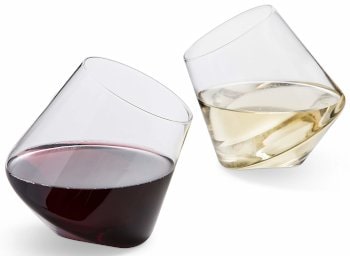
These spinning wine tumblers keep your drink in constant motion, accelerating the process of oxidation to enhance the flavors of the wine. From the delicate lip to the conical base, weight is perfectly distributed so that the wine can swirl without risk of tipping.
7. Tourbillon Aerating Stemless 8 oz. Wine Tumbler Set
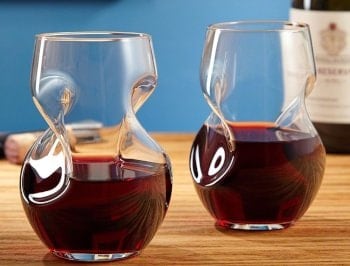
With curves inside and out, the shape of this tumbler spreads the wine as it’s poured so that the largest possible surface area comes into contact with air. As you swirl wine around the glass, the uneven interior breaks up the surface tension, folding more oxygen into the liquid and enhancing the evaporation of harsh ethanol notes.
8. Sommelier Aerating Wine Glass by Chevalier Collection
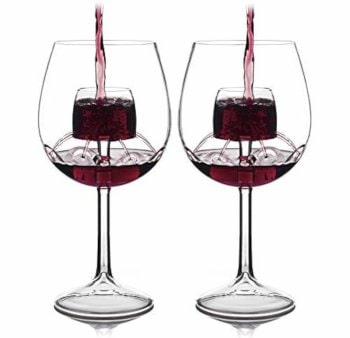
These are one of the few stemmed glasses on the market to also feature a self-aerating design. You first pour the wine into the small interior container, where it runs through the holes into the large outer glass. This forces air bubbles into the liquid to rapidly oxidize the wine, dissolving harsh tannin notes.
Last Updated on April 5, 2019 by Tyler
